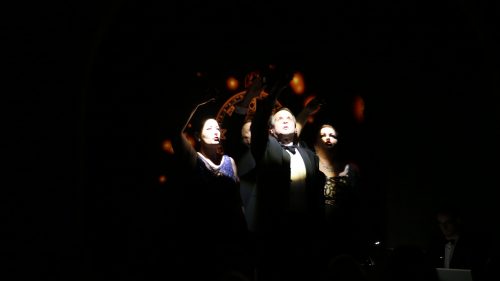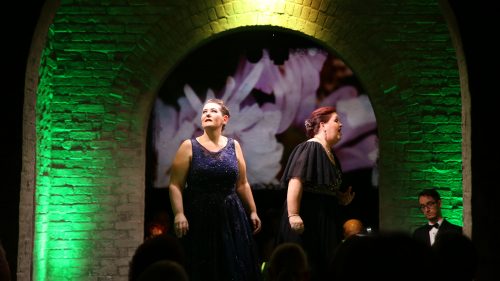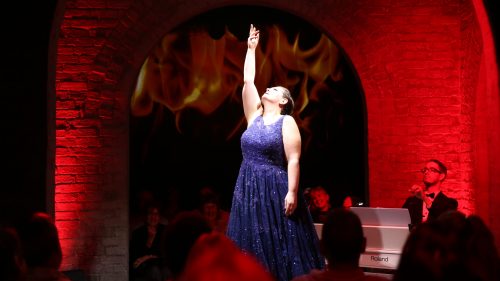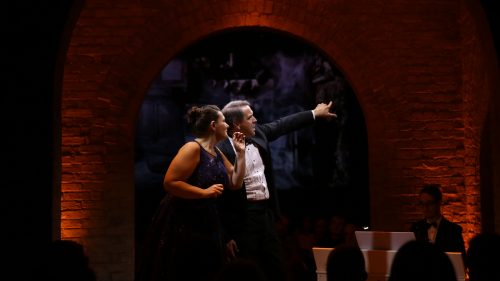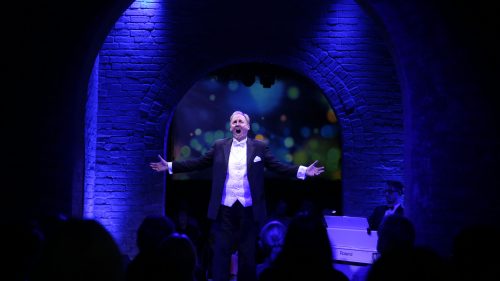 Surrender to excitement. Feel the tension of the upcoming chorus. Do not hesitate, take your feet off the floor. Get out of your chair. Close your eyes, relax and unite with the music.
Surrender to excitement. Feel the tension of the upcoming chorus. Do not hesitate, take your feet off the floor. Get out of your chair. Close your eyes, relax and unite with the music.
This may sound like a promise of a rock concert, but it is something very different. This is Underground Opera Company from Brisbane taking a completely different approach to this art form.
More than 12 years ago, Bruce Edwards got an idea. A former miner, now a producer of operatic performances, aims to change the perspective of opera, which has been perceived as an elitist and expensive form of entertainment for the longest time.
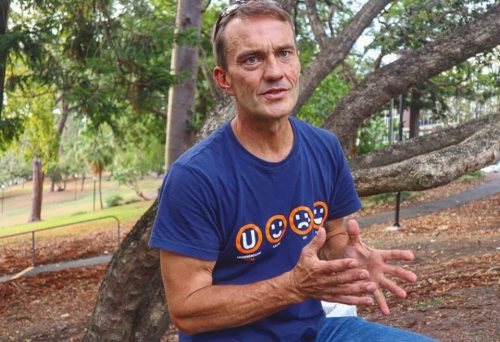
Choosing rather unusual venues for their performances, the goal of Underground Opera Company (UOC) is to make the opera entertaining and accessible for everyone. After more than two decades in mining and tunnel digging, Bruce learned to listen to the underground heartbeat, and then found a way to use nature’s acoustics in the best possible way.
He is still working under the ground, but this time instead of heavy 30-pound drills, he there listens to music. And not just any music, but performances of world-renowned opera singers with whom he achieves almost unimaginable ideas – the most famous operas are echoing in caves, mines and old water reservoirs.
In just such a place, a Spring Hill Reservoir in downtown Brisbane, I met Mr Edwards, a 44-year-old with a contagiously adventurous approach to life.
The idea of an underground opera was born while Bruce was working in a mine in Tasmania.
– A fellow miner I was working with asked me if a heard about an orchestra performing at the mine platforms. I thought it was a great idea, but I wanted to raise that story to a higher level. I wanted it to be more exciting – says Bruce with a smile that captures the joy of the uncertainty and excitement of the unpaved track of his new career.
There are various ways in which UOC artists have become part of this unusual tale. In addition to their love of music and indisputable talent, they all have another very important common feature – they are fun.
– Here in UOC there is no place for an ego of an artist. We come together to create high quality music and create a unique experience for the audience. But still, the most important thing is to have a good time – said Bruce wanting to introduce me to the working atmosphere of this group.
Milica Ilic, soprano of opera music, also had the opportunity to collaborate with UOC and Bruce. Born in Serbia, she has been building her career in New Zealand and Australia and became the Principal artist of the Australian Opera . She says that from all the places where she performed so far, the Capricorn Caves near Brisbane, are the place with the best acoustics.
– Bruce contacted me through the Queensland Opera where I studied as a Young artist and asked me if I wanted to be a part of a UOC concert. I agreed without thinking twice, because I think the idea of using the acoustics of nature in this way is beautiful. All the magic is in the cave surroundings, in the very sounds of nature – says Milica, adding that she supports Bruce's initiative to bring people in a different way to opera and classical music.
Raw talent is not sufficient to pass the UOC casting. Bruce says he kept his “mining temperament” as an effective way of communication in his role as an opera producer.
– Through mining I learned to speak directly and always say what I mean because there was no time for other. I continue to practice it, even if it means that the other side will not be comfortable – adds to explain the meaning of mining temperament.
Divas are not welcome. As soon as he feels that artists don’t see the performance in caves and mines as a unique opportunity and an inspirational challenge, but as a potential obstacle, Bruce knows that this cooperation will not be fruitful.
– I worked as a miner most of my life. I know hard work. What we are trying to do in UOC is definitely a challenge, but miles are far from hard work – Bruce says, reminiscent of the beginnings of his mining days.
From the school day from 9 to 3, with an hour break for lunch, I went straight to shifts of 12 hours of mining work. It quickly teaches you discipline.
The audience who visits UOC performances does not seek perfection, but adventure. Stepping into the caves below the surface with protective helmets for most people is a unique experience itself, and Bruce is aware of this.
– The reaction of all who come here is quite similar, but every time it triggers in me a feeling of satisfaction and confirmation that we are doing the right thing – said Bruce proudly.
Unexpected spectacle
First, silence and cautious steps. Then, fluttering and whispering as they come to their seats trying to capture the essence of the moment through the dark outlines of improvised stage scenery. Excitement is buzzing through the air. The space slowly brightens up and the sounds of thrill arise. This is the beginning of a spectacle that promises everything about this opera will be different.
On a small scene surrounded by audience on all four sides, vocalists appear sometimes accompanied by a small orchestra. The audience, among which is always at least half of those who had never seen an opera live before, has never been closer to the performers. In these operas, the auditorium wants to be part of the experience.
Beware, this is not an opera that has a programmed applause, where you must follow the opera bonton and where you should worry about whether you are adequately dressed. It's enough to just come and relax.
New type of audience
The world of the 21st century is a world overwhelmed bythe offer of everything, at every step. Young consumers and customers are picky, informed and unequivocally know what to expect. They know the exact value of the money invested. The same goes for art lovers. It is not enough to present a quality work – it must contain innovative approach, a factor of “never seen,” excitement and interaction. The recipe for success looks simple – the 21st century audience “just” expects a new experience.
Since its foundation – from Peri's Daphne – Opera has been reserved for those who were part of carefully selected circles. At the time of its formation, it belonged to elites, narrow rings of richness and aristocratic origin. The perception of who the opera was intended for today is, unfortunately, in similar frames.
If you imagine a performance of Pucini’s Tosca or Bizet's Carmen, you will probably have stereotypical images flashing before your eyes:ladies in elegant gowns with tiaras in their hair; elegant fan movements emphasizing their sophistication; a balcony from which, through Galileo's binoculars, serious faces observe a tense storyline in an unknown language and hear voices that sound almost superhuman; intervals between the acts that the same ladies spend in the toilets powdering their noses until they return to their husbands whose necks are adorned with bowties – they wait at the bottom of the stairs that part at the top and take the audience in different directions. Ladies. Gentlemen. Gowns and bowties. Sophisticated, prestigious, elegant – epithets that always go with the reputation of the opera.
Although the Opera looks different today, most people have never had an experience of live opera performance. The reasons in the past were mainly related to the elitism of opera societies, the association of opera with higher education that was not available to broader masses and the issue of status that grew side by side with the feeling of not belonging of an ordinary man into carefully decorated circles of opera lovers.
Today we can speak of several different reasons. Last year's study in the UK showed that the explanations why the British never bought an opera ticket, although one of the most beautiful operas in the world – The Royal Opera House, is in London, lies in the outlines of the above-described image. The fact that they are not sure what to wear, tickets which are too expensive, fear they won’t understand it, and that they are not sure how to behave in breaks, or when to applaud, surely sound trivial, but these are the main reasons for a low turnout at the Opera in London. Although, according to the British Office of Statistics, an average Briton spends 13% of his income on culture and recreation, most of them still don’t decide to spend any pounds on a pleasant Sunday evening at the Royal Opera House.
Britain is not the only country that shows declining trend of visibility and popularity of operatic performances. NY Met is another good example where visiting traditional opera houses and performances is not on a popular entertainment list. In the period from 2015 to 2018, its occupancy varied between 65 and 66 percent, leaving a space of 4,000 places almost half-empty.
Brisbane and Edward’s Underground Opera is a great example of an attempt to present the opera in a more modern light. Looking at the worrying consequences of such statistics, awareness has raised around the globe. Those who want to keep opera alive in the 21st century are realizing fast that it must be exposed to re-branding and reputation management and are taking different steps of popularization.
New York
Metropolitan opera in New York was founded in Broadway in 1883 by a group of rich businessmen with the ambition to create their own theater. Throughout the next century, many great artists found their home in New York City's opera – Lawrence Tibet, the first American baritone appeared more than 600 times on the Met opera scene. From the mid-60s of the last century this Opera is at another location and with a new goal – to gain new audiences, educate young people and be accessible to everyone.
For the past 10 years, Met Opera has been organizing The Met: Live in HD, a series of opera performance displayed in high resolution in cinemas all over the world. Out of the planned 6 shows, the project has expanded to 10, to finally reach broadcasts in more than 2000 settings in 73 countries on 6 continents. Later, these performances were also available on TV screens. Scenes behind the camera showing artists as ordinary people made of blood and flesh talking about the process behind sounding perfect, hundreds of hours of preparation, practice and mistakes, gave the audience a new dimension and intimacy with the performers.
The most recent initiative of this institution is the project of including free of charge transmission of opera live in schools in the state of New York in cooperation with the Ministry of Education with interactive workshops and meet ups of participants with students. Although Metropolitan Opera is creative in finding ways to reach the interest and ear of youngsters through these affirmative actions, Met Opera's attendance remains standing on the thin ice.
London
Another interesting initiative was created in London under the name of the Silent Opera. A group of creative operatic enthusiasts followed the signpost of the ,,Silent disco” concept –a party that does not include have vibrating speakers and loud music. Several DJs play music, everyone has their headphones on and are able to adjust the sound level and choose their favorite songs. The result is an unusual intimate music experience for the listeners, all in the room full of people moving to the rhythm of chosen music. The inspiration for this idea was found in the Japanese 60’ science-fiction movie, ,,Summer of 1993”, but it reached its glory after 2000 when BBC organized silent festivals in Britain and a Dutch artist Meg Duguid started throwing extravagant silent parties at the Museum of Contemporary Art in Chicago.
This idea was taken over by the Londoners and the Silent Opera was formed, which attracts the new audience in a creative, modern way. The audience is mostly made up of people younger than 30, of whom between 30 and 60 percent have never heard classical music or opera before. The audience can choose whether the live performance will indeed be live – listening to the operatic vocal accompanied by 6 instruments performing on the stage, or putting on the headphones and enjoying the pre-recorded version of the opera that takes place before them. According to the creative director of the London Opera House, Daisy Evans, opera has never been experienced like this before.”This is the opera of the next generation,” says Mrs. Evans.
Comparing to Royal Opera House, their budget and domain is incomparably smaller, but also much more receptive to the 21st century audience who are looking for a new, different experience without compromising on quality.
It seems that the opera with its image of mighty, elevated and static does not swim best in the rapid waters of the 21st century. It still occupies a place in the public's head as an old-fashioned, somewhat boring, scaled for those of older age and a deeper pocket. Unfairly, it still carries this burden of expensive and elitist with itself today. This is the main reason why it is not popular among younger population.
If the Opera Houses around the globe want to fill up the empty seats and provoke the excitement of a demanding young audience, it will have to persevere in exploring new ways to attract viewers who always think it’s all old news. It will have to invent a new language to teach people how to love opera once again.
(Marija Rašović is originally a journalist from Podgorica, in love with travelling. After a degree in journalism obtained at the Faculty of Political Sciences in Belgrade, she completed Masters in Madrid. She now lives and works in Abu Dhabi. And she travels… Her observations poured into words, esteem readers, you will be able to read here, on MNE magazin portal in the section ,,Travelling around the world” and photographs from her travels can be viewed at the Instagram profile: montenegro_magazin_travel )



